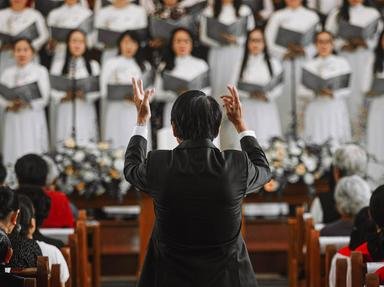Quiz Answer Key and Fun Facts
1. By the end of the nineteenth century, hymns had entered the public consciousness to such a degree that some publishers were paying writers to produce a weekly output. The most prolific and popular of these was a blind American lady whose married name was Frances Van Alsteyne but who retained her maiden name in addition to using over 200 different pseudonyms. By which of these names is she best known?
2. The song, "There Were Ninety and Nine", was often used by the American Evangelistic team of Dwight L. Moody and Ira D. Sankey. They came across the words in a Scottish newspaper but what was unusual about the tune written by Sankey?
3. Philip Bliss was another hymn writing evangelist of the nineteenth century. Which of the following is his composition?
4. Many hymns are written against the backdrop of personal suffering but few can rival the hymn that is the subject of this question. Its author, Horatio Spafford, lost his business in the Chicago fire of 1871 and then, two years later, heard the news that his four daughters had drowned en route to Europe. Which hymn was written as his response?
5. There were many who looked down upon the overly emotional nature of nineteenth century evangelicalism. Among them was the Quaker poet, John Greenleaf Whittier, who wrote a long poem likening the revivalist meetings to ancient religious rituals based around the brewing of the soma drink! This might, by now, have been largely forgotten except that a very familiar hymn has been extracted from the poem's closing stanzas. Which hymn is this?
6. Prominent among American hymn writers were several Unitarians who brought a strong social awareness to their compositions. One of these was John Pierpoint (1785-1866) who may be better known today for having sired James Lord Pierpoint, the composer of a very popular Christmas ditty. Which of these songs did he write?
7. "Ave Maria" is one of the most popular of religious songs from the Catholic tradition. It was composed in 1859 by the French composer Charles Gounod who used elements from the work of which earlier composer, also noted for his church music?
8. Several significant hymns from this period were written by single women whose lives were incapacitated by infirmity or poor health. Among these was which English author, responsible for the hymns, "Thy Life for Me", "Take my Life and Let It Be", "Like a River Glorious", "Who Is on the Lord's Side?" and "Master Speak, Thy Servant Heareth"?
9. Which of these hymns was originally written as a song by which Sunday School children could march from one village to another?
10. Susan Warner and her sister Anna wrote novels, conducted Bible studies for cadets at West Point Military Academy, and were responsible for the popular children's hymns, "Jesus Bids Us Shine" and "Jesus Loves Me, This I Know". When Susan died, in 1885, which honor was bestowed upon her?
Source: Author
glendathecat
This quiz was reviewed by FunTrivia editor
kyleisalive before going online.
Any errors found in FunTrivia content are routinely corrected through our feedback system.

